MID-MISSOURI OLD ORDER AMISH POPULATIONS SOAR and expand into new states and fight for their traditions, their lifes and their GOD and WIN !
In the past twenty years, Amish populations have doubled expanding into new corners of the U.S. bringing the Old Order’s numbers to around 231,000 living in 28 states…finally reaching their Promised Land.

Since the beginning the Amish have tried to stay away from Society so they could concentrate on their God, their family and their survival. Early on it was easier but as the country has grown so has the friction between these religious conservatives and most everyone outside their circle of friends. In the beginning when Jacob Hochstetler the immigrant of 1736 first landed in Philadelphia, a city of 8-10,000 people, the wilderness was within 50 miles of the city. Hochsteler escaped the overpopulation of Europe where land was impossible to buy and soon, he had a family and farm. One night Indians attacked their cabin, burned it down around them while they hid in a root cellar and were taken prisoner when they surfaced the next day. The man who refused to fire his musket at the Indians who attacked now watched as one tomahawked his wife and a child. Hochstetler and his two sons were taken prisoner for years. After his escape this pioneer helped found the first Amish Church in America around 1749, the Second Amish Church was founded in Lancaster, Pa., long famous hub of the horse and buggy culture where the Amish began splintering into new groups and new devotions.
PHOTOGRAPHS by P.K. WEIS / SOUTHWESTPHOTOBANK.COM
PBS AMISH SPECIAL Click here
<img src=” “=”Amish Children learn early how to handle large animals…”
“=”Amish Children learn early how to handle large animals…” 
Most Amish believe that farming is the simplest and best way of life. They use old farming methods.“A tractor gets the work done more quickly, but horses and the love of hard work keeps us nearer to God,” one Amish man explained…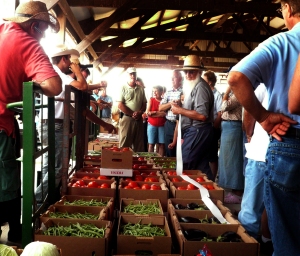
The Amish haven’t always been called backward, the Old Order Amish, whose black hats and plain clothes made Lancaster, Pennsylvania famous were fairly contemporary until the turn of the 1900 century. It was then these folks freeze-framed in time and chose to dress plainly to shun buttons, zippers and most everything else that the 20-21th century produced. Still they shop at Walmart for the prices and but the self-sufficient Amish are expanding in number and smaller colonies are popping up where ever these farmers can pull together large blocks of land at rock bottom prices. High land prices in Iowa have encouraged resettlement in rural Missouri.

Hard times are everywhere and the Amish lifestyle is flourishing and surprisingly-it preaches a plain hard simple life living a 1880 lifestyle in a 21st Century World. Since the 1720’s the Amish Church helped push back the American frontier, cleared the land and their settlements became the center of civilization, around 1880 everything changed. They withdrew into colonies and let the world pass them by. Since then they have grown steadily, morphing into various orders with varying beliefs, many of which, change as the outside world applies pressures upon them.
Today Jamesport Missouri is the apex of this religious migration, the Amish arrived there 60 years ago and as people have left small town America, the Amish have moved in. Tourists from Kansas City shop the boutiques and antique stores as Amish traffic ebb and flows from Jamesport Groceries. Some tourists rest their legs on the benches lining the main drag and all eyes turn to the four-way stop, as a horse and buggy, makes the turn. Across the street, a Mennonite waitress on break chats on a cell phone in front of Gingrich’s Pantry, shoppers enjoy bluegrass music pumped-in curbside, as they shop for quilts and antiques.
Natha McAllister, editor of the Tri-County Weekly. scarcely notices the horse and buggy traffic outside from her desk by the front window. She believes Jamesport and the Amish have benefited mutually over the years, the city advertises both the big Mother’s Day celebration and their huge Amish quilt auction in the fall.
During the hot summer, tourists love to escape Kansas City and take a day trip to Jamesport, Taking the day off and tripping back in time, add a little Dutch pastry, which is the perfect end to a perfect day. The country roads surrounding Jamesport are lined with signs selling produce, rugs, harnesses and baked goods.
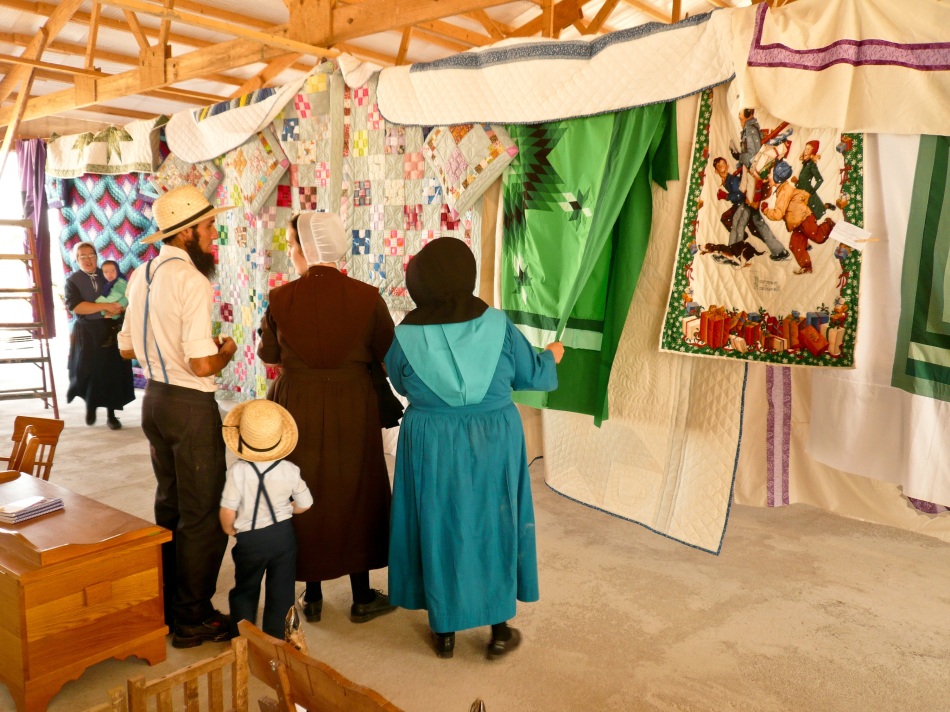
In hard times, the Amish have often found less profit in farming, and looked for other ways to add to their lifestyle. Many are cooks and carpenters and set up bakeries, furniture or cabinet-making shops where they work-when farming allows. Others work in town, embracing the English world of a fair wage for a fair day worked. “Several crews go into the city (Kansas City) everyday” says McAllister, much of that construction work has disappeared for now she adds, “but they have their projects and keep busy”.
”Locally, they raise produce commercially.” “In 1986 as we developed the town’s gift shops, specialty boutiques’ and antique barns, “the Amish also started to capitalize on the influx of tourists”.
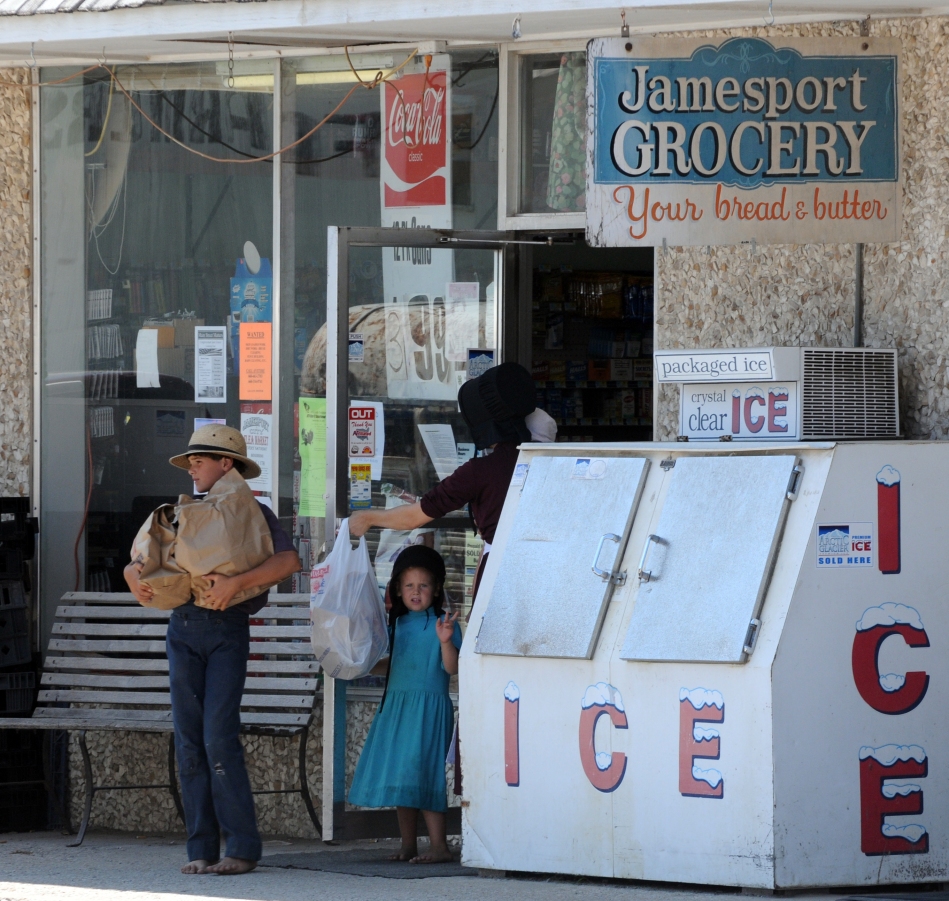
Further north in Iowa, the Amish and numerous orders or sects or splinter groups are good business. Most live in settlements and attract tourism that in turn brings business to the rest of the community most of whom enjoy the clip-clop of horse hoofs.
Numerous communities claim to have the largest settlements of Amish and visiting the quaint Old Order Amish settlements, a land where the horse is still king, can be good business and a popular pastime in the Midwest. To capitalize on that business Buchanan County, Iowa launched a web site that promotes their county and their Amish who in turn, bring in the tourists. Visitiowa.org promises “ a blend of the old and new”, no matter the time of year escape the world’s stresses says the website and “drive through Amish country during planting and harvesting season to compare the past with the present” the site was designed to attract tourists to six counties in northeast Iowa.Kalona, Iowa (pop 2300) known as the “Quilt Capital of Iowa” claims on its website to be the largest Amish-Mennonite community west of the Mississippi River, but note, this community is divided into Mennonites, Old-Order Mennonites, Amish, Old-Order Amish and Beachy Amish-Mennonites. “Kalona welcomes you to refresh yourself in the simple pleasures” it says. “Appreciate the area’s rich heritage and living history” says kalonachamber.com. The Chamber of Commerce site trumpets a “visionary digital fiber optic phone network” being installed but quickly points out that the Amish farms will not have a party line in this network.
In the barnyards around Kalona, the New Order Amish permit rubber tires on their buggies and farm vehicles, while the “Beachy” (named for their founder) use electricity and telephones, drive cars, and own modern conveniences including farm equipment.
Outside the rural community of Osage Iowa, the Mennonite tractor shop has 15-16 newish tractors, sitting out front, awaiting repair. Chances are, those tractors won’t ever make it back into town to the dealership—and that can be the seeds of hard feelings in a small town says Mark Kuhn, a member of Iowa’s general assembly from Charles City. Kuhn serves on the assembly’s agriculture committee and often serves as a spokesman for his constituents, both Amish and Mennonite, alike, make up 120 farm families in his district.
Kuhn believes “jealously and petty stuff” makes up many minds and color attitudes with “missed opportunities”, like “my son didn’t get a chance to farm that land because you bought it”, as the Amish farmers move in and buy up lots of local land.
The Amish organized Mitchell County Produce auction generates $1.6 million yearly and very successfully creates a collective that is difficult for other farmers to match, so it isn’t surprising to find factions in the community who take exceptions to their lifestyles and target them with legislation.
Ivan Martin, manager of the Cedar Valley Produce Auction near Elma, Iowa said he is afraid a Mitchell County ban on steel wheels will keep the Mennonite enterprise from happening each year.“Seventy-five percent of my growers are affected” by the steel wheel ordinance, he said. Growers who brought in $1 million into the business serving 3600 permanent buyers, some who drive in from Nebraska, last year are having to find different ways to get to market. Some hire others to bring their loads “and some just take the risk” of using their steel-wheeled tractors on Mitchell County roads. To counter this, Mitchell County doubled the amounts of fines saying present fines did not have the desired affect. Martin says It is becoming increasingly hard for growers to get to auction. The business sits on the Howard County side of a county line road. “I have some growers who drive gravel to the Elma hard top (in Howard County, west of the business) and then come back up to drive on the Howard County side, just to stay in Howard County,” Martin said.
The Howard County’s Board of Supervisors worked out a compromise with its Mennonite neighbors. Mennonites created a fund to help pay for damaged roads, Mitchell County refused the same proposition and Bob Marreel said they had to post $8 Million (the amount the county spent last fall on new roads) or no deal.
One pet peeve of Kuhn’s is the $11 million bond for wind power generation the county invested in, forcing the Amish to pay their fair share, knowing full well they will never benefit from the power. Likewise, they are exempt of taxes for public schools that they are not required to attend, which causes community resentment as educational facilities struggle to get by.
The most recent hardship for Amish and Mennonite’s in Iowa’s Mitchell County was Ordinance #41 passed in 2009 banning the use of steel wheels on paved roadways so it couldn’t have been too big a surprise when a Sheriff deputy cited a 13 year-old Mennonite boy for having steel wheels on a public roadway.
Two other Iowa counties, nearby Buchanan and Howard County, both dealing with the same “steel wheel” issue accepted a $25,000 bond on deposit at a local bank, placed there by the Amish to be used by the county in case of damage is caused by their metal wheels. Mitchell County refused the same proposition insisting their farmers remove their steel and move to rubber wheels or post a $8 million bond.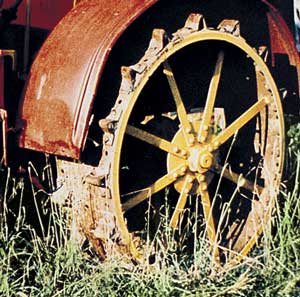
Tractors with steel wheels have long been a tradition in the Osage Mennonite/Amish community the cleat wheels give farmers traction in wet fields and keeps farmers close to home and their minds on the farm.
Rep Kuhn says this boy was working on his family farm when many others his age are on utube or playing computer games and hoped a strong first amendment fight could gather steam behind this 13-year-old young man’s plight. But Iowa’s Supreme Court refused to hear the case and lower courts upheld the county’s right to cite Iowan’s driving steel wheel vehicles.
Matthew Zimmerman was cited driving an tractor weighing about 19,000 pounds, this tractor was pulling a homemade two-wheel cart on a county road when stopped by a sheriff’s deputy and Mitchell County Supervisor Bob Marreel. A month later, at the initial trial, Zimmerman was found guilty of not having a tow chain and pleaded not guilty to steel wheel charges. When Mennonite elders pointed out that steel wheel use “is not a tradition that can be abandoned, and that “there are consequences (for them) with the church, including excommunication.
The Elders were told the only issue was damage to county roads. “We’re not going after their religion. We’re going after their tradition,” Bob Marreel said. “I want that tradition to end.” “And I want them to convert to rubber tires.”
“Some of the people thought we singling out a certain type of people. We were, I guess, steel-wheel people.” says Marreel.
A couple months ago, another steel wheel case reared up in court and many locals questioned the fairness of charging a local Mennonite $10,000 for damage done to a county gravel road. The Mitchell County Board of Supervisors eventually accepted $2,500 from Mennonite farmer Jonas Leid to pay for damages to a rural gravel road the board said was caused by his steel-wheeled tractor.
Locals said more than 250 semi-trucks travel that road and charging one farmer with one tractor the cost of the entire roadway to be punitive and irresponsible. Farmer Jonas Leid took back his $10,000 check from Supervisor Bob Marreel and left paying an agreed upon $2500. Marreel had videotaped the farmer driving on the roadway and had insisted the Mennonite pay the entire cost of graveling the roadway.
The Osage community sentiment appears split down the middle as almost 60 comments posted on with the Globe-Gazette argued the rulings. Most believe these religious folks should be allowed to practice their religion-but some say traditions can change and historically have changed from pressures from the outside. Following the changes in the Mennonite-Amish Church, they are right, the Amish Order alone, have at least eight different orders. Some orders live differently from the same order found elsewhere. All of them do things differently, some even speak English and dress English and work in town and drive cars, that being one extreme the Old Order Amish may well be the other, time-warped in the 1880’s. It is fair to say they are slow to change and go to great lengths “not to conform” as they preach.
“The steel wheels help keep Old Order farmers on a smaller scale,” said Ivan Martin of Elma, who grew up in the Old Order. Although Martin later chose to drive automobiles, he said he understood the importance of the steel wheels to the Old Order. He said the practice supports a belief that small farms help hold together communities and keeps faith in perspective. Use of rubber tires — automobiles — could both symbolically and literally provide a means for communities to become more mobile. That, he said, can destroy small communities. “I am afraid the next generation will move away,” he said, as the steel wheel usage goes into a forced decline. “I am afraid it could kill the Old Order church,” so told Martin to the Mitchell County newspaper.
The Iowa Supreme Court ruled February 07, 2012 that Mitchell County’s steel wheels ordinance violated a Mennonite’s right to religious freedom.
“We … hold that the application of the Mitchell County road protection ordinance to Matthew Zimmerman violates his rights of free exercise of religion under the First Amendment to the United States Constitution,” the court ruled. There was unanimous agreement.
Matthew Zimmerman, 15, was found guilty in 2010 by a Mitchell County magistrate of violating the county ordinance. He paid a fine, but his family appealed for a dismissal in district court. Judge Bryan McKinley upheld the magistrate’s ruling. The Zimmermans then took their case to the high court. The court said the use of steel wheels had a 40-year history in the county and it was not until the county began a 2009 paving project- that to date has cost $16 million – that the use of the wheels became an issue. While the court agreed the ordinance language was devoid of religious references, “we must recognize the ordinance was adopted specifically to address use of the resurfaced concrete roads by steel wheel tractors.
“This is not a case where new activity brushed up against a pre-existing ordinance but where an ordinance was passed to deal with a longstanding religious practice,” the court said. “… the County declined in September 2009 to regulate various other sources of road damage besides steel wheels. Rather, it chose to prohibit only a particular source of harm to the roads that had religious origin,” the court said.
While there was evidence presented of damage done to county roads, “The county engineer admitted that various factors lead to road deterioration and he county not quantify the impact of steel wheels on the County’s normal schedule for road repair or resurfacing it,” the court said. Daniel Zimmerman, father of Matthew Zimmerman, the Mennonite teenager at the heart of an Iowa Supreme Court case, said the ruling shows the power of a group of people working together for a cause. He added he was not surprised by the decision that religious rights should prevail over the county’s ordinance banning steel wheels.
“Religious freedom is why this great country was founded,” said Zimmerman. “I was always optimistic about the outcome, otherwise we never would have pushed it this far. “It’s just a shame it took this long.”Despite months of controversy, “This is not about ‘us versus them’ … it should not be about personal politics,” said Zimmerman.
“I hope we can work to find a workable compromise going forward. Iowa is a good place, and we want to carry on here.”

The Clark, Missouri Old-Order Amish shun electricity, plumbing and telephone. In Jamesport, instead of outhouses for their plumbing most Amish have a booth out front of the house to keep the phone out of the home. “They think if a phone is in the house, it is a luxury and the household would spend too much time talking on the phone and not getting the work done,” so says McAllister.
Also, it is too modern she says. Likewise, Jamesport Amish do not use electricity, but they do use solar panels to charge their batteries. “They all have plumbing in their homes, many have more than one bathroom. Many have cell phones, and portable phones from the main phone located in the booth. In the past year and half, most Amish families, have added propane, rather than kerosene, which has helped says McAllister of her neighbors, many of them she attended school with prior to the Supreme Court Ruling in the early 1970’s that said the Amish could educate their own.
Natha McAllister, editor of the Tri-County Weekly in Jamesport is one of the first to call the Clark Mo Old-Order Amish “backward”, she complained folks there failed to use the “slow vehicle triangle” reflector to warn folks they are coming up too quickly upon a horse and slow moving buggy. “That’s dangerous!” she complained.
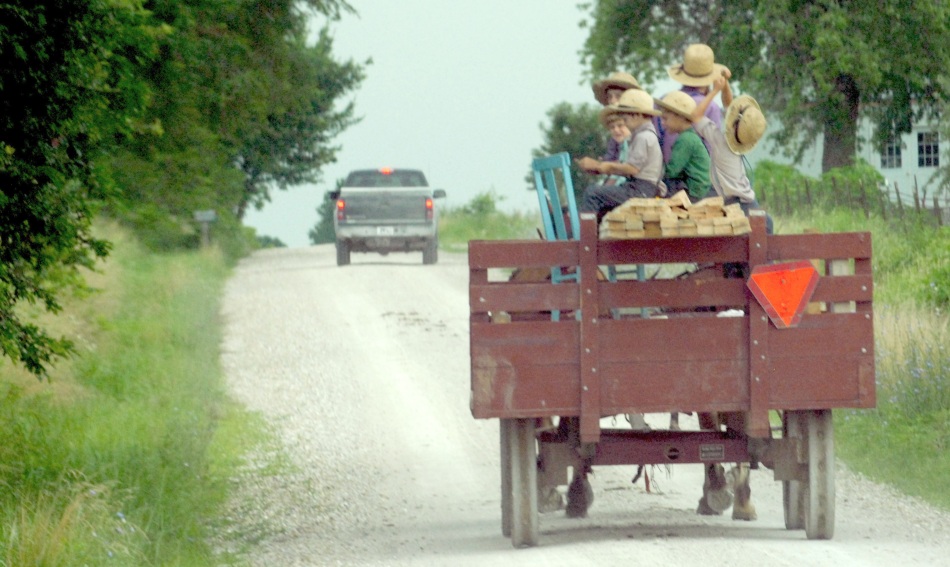
If you had told Eli Borntrager he was backward. He would have smiled and moved on. The 29 year-old father of five was a member of the Clark Old Order Amish and they have a long history of turning the other cheek. So when Eli’s world collided with a text-messaging motorist, and a Chevrolet that ran over slow-moving Eli, his horse and buggy, without ever touching the brake—it was no surprise to the Amish his family refused to file a lawsuit, even after homicide charges were filed. That would be like trying to get even”, says a neighbor identified only as Miller “the Bible teaches us, instead of getting even, we should just to move on”. The driver was eventually freed on probation never spending a day in jail, the charge of text-messaging he denied, but phone records showed he had been active. Eli had displayed his triangle but the Twenty-first Century ran him down. Leaving behind a farm, wife and five children. Today, two neighbors pitch in to help around the farm, get the crops harvested and planted–they say the family is getting along okay.
 Drink of water for Eli Bortrager from one of the five children left without a father…
Drink of water for Eli Bortrager from one of the five children left without a father…
Eli Borntrager a couple years before his fatal crash.
In the past five years, four buggy crashes, have occurred on a four-lane highway near Ft. Campbell, KY Army Base, in the same period Lancaster County has had 146 buggy-vehicle accidents with a total of 205 injuries and seven deaths. Last year, Issac Stoltzfus, a thirty-year-old Amish dairy Farmer, was rear-ended throwing his family from the carriage, killing his two year old daughter, Barbara. Now Amish in some communities are rethinking their buggies using flashing LED taillights, windshield wipers, and rear view mirrors.
Throughout the U.S. efforts are made to keep fast moving traffic away from Amish horse and buggies. Road shoulder widening in Iowa where steel wheel tractors move to and from the fields, county agents bought additional right-a-away and expanded the roadway to accommodate the Mennonite tractors and local traffic, alike. Elsewhere buggies are allowed to ride under and over expressways and road-safety manuals have been designed for buggy owner/operators. But change continues to come slowly to the horse and buggy culture.

Missouri Amish populations have been estimated at more than 5000. Jamesport has 120 families and Clark has more than a 150 households, possibly 2,000 members making Clark perhaps the largest pure Old Order Amish population west of the Mississippi, but you wouldn’t know it if you lived nearby.
Since they arrived in the early 1950’s they have always taken care not to compete with the businesses in town. They stick close to home and the settlement doesn’t allow their members to work in town Amish carpenters can pickup a job occasionally, but not every day. The Amish started a large produce auction that fills quickly on summer days and everything is gone by the end of the afternoon.
A large five horse team carefully picks its way through a tangled field of green-the Amish farmer stops to let the horses breathe before taking on the next row of tangled weeds and soy beans. This Amish farmer had been promised $27 a bushel from Japanese buyers for the organic crop free of pesticides and weed-killers, now they have backed out, he says.
One buyer says he will pay a $18 a bushel-he sighs and starts up the team saying “that’s still twice what we get for the regular”. Only ten percent of Amish farmers still farm a 100 percent of the time. First, the Amish say they need at least a hundred acres to farm, just to make it pay off, and then what will your sons do, buy more land?

The Clark Colony has a buggy and wagon-maker, a grocery, feed and seed sales, furniture and cabinet-makers, a few Amish raise deer hoping to sell trophies and their bakeries are full of white, wheat, raisin bread, cakes, cookies and strudel. You can buy rugs, blankets, quilts, saddles, harness and fryers along with the occasional beaver hat or a headless catfish, if you’re lucky.
You can get anything you need built there and vinyl house sidings has become the rage of the countryside. Recently, huge igloo cooler, have also become popular. They are large outbuildings covered in thick insulation and they are filled to the brim mid-winter with slabs of ice sawed from the pond. This will keep your berries fresh forever.

The Amish in Clark bought belt-driven 1940-50 vintage wheat-thrashers from Amish in Canada who ship them down on semi-tractor trailers to Missouri. Power units fueled by gas, power everything in the fields or in furniture shops, they power the numerous sanders and saws which are installed in a line and are all powered off a single shaft.
Two thousand of the strictest Amish have lived near Clark since 1950 when they first arrived looking for land. They grew from one school district to twelve and now groups are breaking away and starting up new colonies, many with new rules—some are looking to ease their burden a bit.
Ten Mile, a rural four-way stop, near Macon, Mo. is one new group who now permits a warm stocking cap rather the traditional wear and snow shields for the front of their buggies to fight the wind chill of Missouri sub-freezing winters. And they can work in town—every day. At a time when everyone can use more work, they’re no different.
At a time when almost every other religion is loosing people, the Amish are thriving, amongst the Clark Amish, of the 150 family, approximately 100 of those families have new born.
http://www.usatoday.com/news/religion/2010-09-14-amish-population_N.htm

Since the 1970’s the Amish have taught their own schools. Usually the better student takes over teaching from the last and students attend until age 15, reaching the 9th grade, while the new Keytesville colony children only reach the 8th grade and age 14. The three-year-old settlement just built its second school with 23 students in one and 26 in the older one and all students get time off to work in the fields. In school, Amish kids learn the English language but at home, they get their chores and instruction in a Pennsylvania/Dutch dialect they learn from birth and they learn of the “English world” from neighbors and Walmart.
At home, children learn farming, cooking, sewing and gardening and at school Amish teachers teach reading, writing, arithmetic and English in Clark, teachers are the best student who becomes the teacher and they teach until they don’t want to. The Clark Amish now have seven schools, just built 3 last year because their was so much demand. This year, a sixty year old women will be teaching one of the districts or one-room schoolhouse, assisted by her husband, both have the time. In Iowa, that state‘s law requires Amish teachers to be certified and several times, have tried to force Amish students to attend public school. Each time the Amish have refused and eventually Iowa have folded giving in to the Amish farmers.
Last summer a five-year-old fell off a barn roof near Clark, breaking both wrists, he was to start school in a few weeks. Six months earlier a classmate fell from the hayloft striking his head on concrete below, he was rushed to a hospital with blood coming from his ears, after a battery of tests and a $7,000 hospital bill he was released. His father, an old horse-trader, settled the bill for less than $5000 cash.
While some colonies shun those who leave the Church and the lifestyle, the Clark Colony “communicate but don’t socialize” with those who chose to leave. In Clark you are born into the Church and your only choice is to stay or leave. Elsewhere, like in Pennsylvania ‘s Lancaster County youth live the life and freely join at 18 by their own choice. Some settlements allow the kids cars and other worldly pleasures the year before they enjoy their 18th birthday.
In the early days, the Clark Amish settled a dispute with Missouri Public Health over refrigerating their milk storage and by working with the milk distributors who built numerous (more than 28) refrigeration stations in which the Amish pour their milk and the distributor maintains and electrifies the stations using money taken from Amish profits.
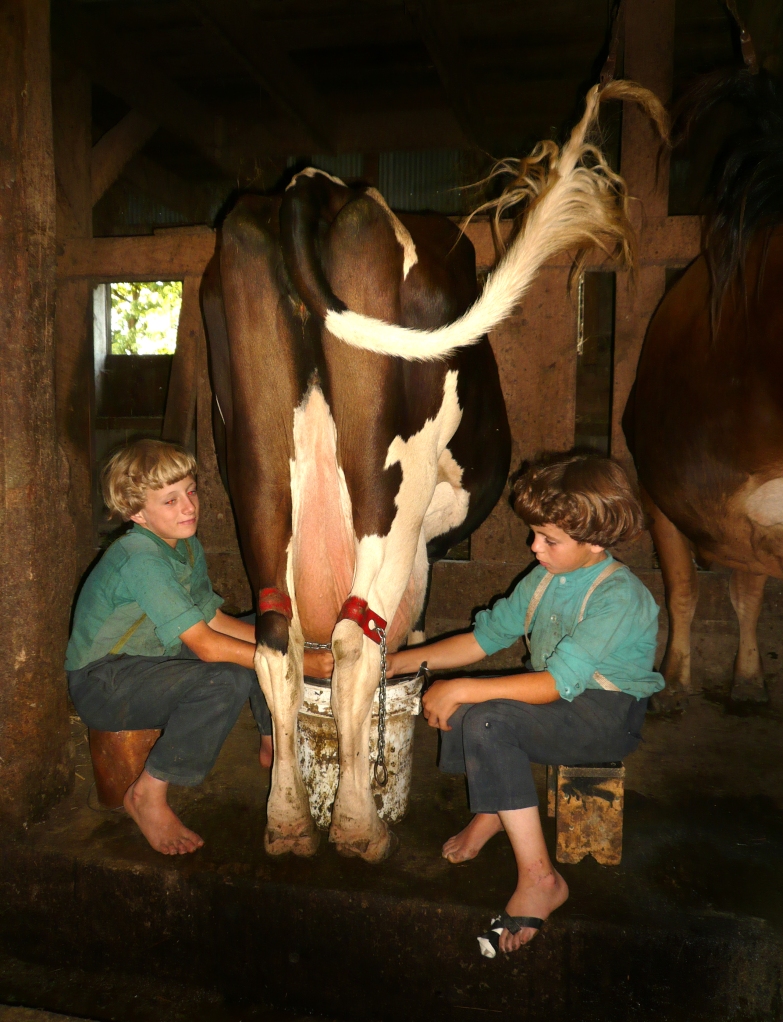
“Milk used to be everything!”, says Joseph Miller, we used to make enough off milk to settle the bills. Today we get half that price and now folks are selling dairy cows. “You can’t make it on milk alone now days, not anymore, not with those prices!” he said.
So everyone now has a sawmill English drivers deliver lumber to Miller’s mill and eight other full-time working mills. The huge buzz saw whines and sawdust flies as horse-drawn wagons unload semi-trailers loaded with trees for milling. Everyone, young and old, have a place in the sawmill, each adds their touch to the raw wood as it moves down the line fast becoming a board.
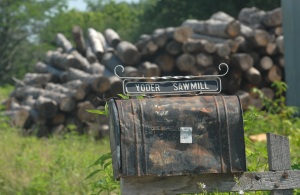
Outside his six-day-a-week sawmill is a pile of sawdust with a sign, saying simply “walnut”, as dust flies over the sign accumulating in an ever-increasing pile. Miller says he placed the sign in case, folks didn’t know it was walnut.
Apparently everyone in Amish country knows if you place walnut tree sawdust in a horse stall that horse’s hooves will split, who knew ?
In Keytesville, Mo “about two years ago 15-20 families came in, buying sections and dividing them with kids” says Darrin Gladbach. Chariton County Assessor.“ A Floyd Miller from Clark bought 160 acres, he was joined by families from Iowa and Wisconsin. “My take on it,” says Gladbach, “is they hope to put large tracts of land together and given the price of the land”, he says “they are buying pretty poor land.”
In spite of harsh times, the new colony has just shy of a hundred children and with almost fifty adults. Enu Miller from Osage, Iowa was glad to find sixty acres here for his livestock, oats and eight children who help him produce exquisite walnut cabinets in his woodworking shop and his wife bakes cookies and bread.
Miller blames high land prices in Iowa as the reason he moved to rural and isolated Missouri but increasing Mennonite-Amish growth continue to cause friction within the communities where they flourish. The Osage Iowa’s newspaper reveals a community up in arms over a 13-year-old Mennonite boy driving a steel wheeled tractor, who was cited with four charges including steel wheel use. Efforts went to the Iowa Supreme Court who refused to hear the case as a test of the 1st Amendment and the county ordinance upheld by lower courts. Community members have expressed concern these issue will force Mennonites to move away, people like Enu Miller.
Seventy-five miles miles away the Clark colony is landlocked and needs space to grow. Amish populations have doubled in 20 years bringing the Order’s numbers to around 231,000 living in 28 states.
Barbara Miller, an Old-Order Amish re-settler, is not surprised, to learn of the Amish growth around the country, in spite her religion encourages a lack of knowledge of the outside world and its enticement. Most of that goes out the window with their first trip to Walmart, and she knows “the younger generation is a lot bigger than it was 20 years ago” says Miller in her new colony 75 miles from the last, in Clark, Mo. Barbara Miller, formerly Yoder and was one of 18 kids, her stepmother had moved to Clark from Indiana after her mother had died of a burst appendix. Her father, Elmer Yoder, was written a women who was available. He had long hoped for 20 children and since he had ten kids with his first wife, he married again and raised another eight hoping to reach his goal. He fell short by one. Miller moved to Keytesville, Mo area with her husband about four years ago and almost instantly gas prices went up and milk prices began to drop down to levels not seen in twenty years. Since then distant cousins from Iowa and Wisconsin have moved in and all are trying to carve out a new life.
This recession is felt less by subsistence farmers who grow much what is served on their table but small farms and farmers have been disappearing for years, so when it tightens up for them, its tight. “We were going to milk!”, says Barbara Miller, “we put up the barn, a year ago and bought half the cows (16) and then the milk inspector said we better not get the rest. “Now we’re just trying to hang on,” says the 40-year-old mother of twelve. “If they (the Clark, Mo settlement) can’t make, how can we? Miller exclaims. “We have a (diesel) chiller in the barn, it has never been hooked up, not sure now we’ll ever use it.”They didn’t. A few months after my conversation with Barbara Miller, she and her husband moved to La Plata, Missouri to a newer community springing up as another satellite group of the Clark, Missouri community but close to the community of Ten Mile, Mo another offspring of the Clark Millers so by keeping family just down the road.
both Amish and “English” 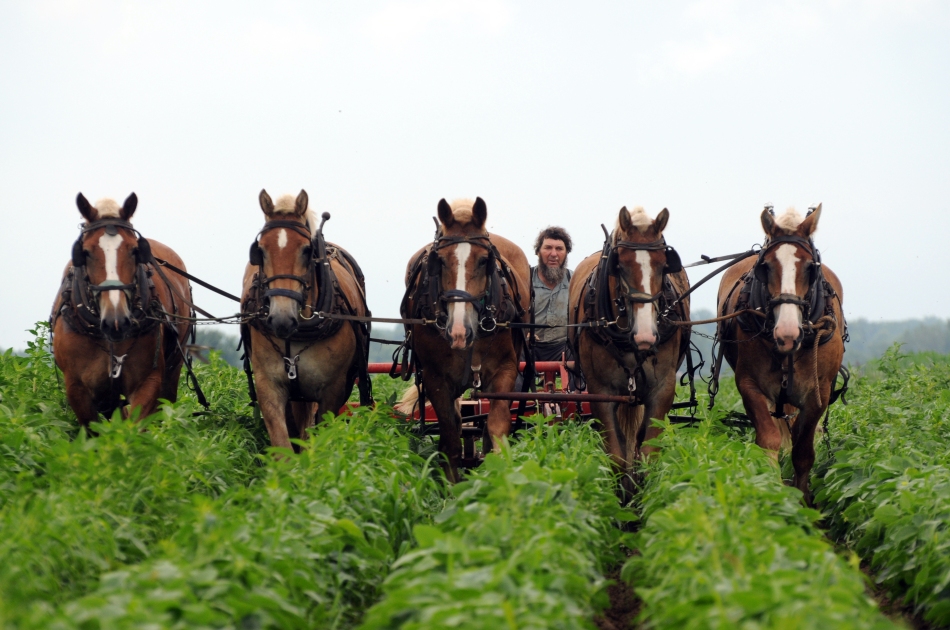 The OLD ORDER AMISH of Mid-Missouri showed up in 1950. Cheap farm land, lots of it, where large tracts can be butted up against others and clans can build a life and home centered on their lifestyle and religion and keep the outside out, minimize the distractions.
The OLD ORDER AMISH of Mid-Missouri showed up in 1950. Cheap farm land, lots of it, where large tracts can be butted up against others and clans can build a life and home centered on their lifestyle and religion and keep the outside out, minimize the distractions. Many young Amish born into the faith never question whether this way of life is for them or not, it is all they have ever known. Young Amish like Charles Miller Jr find the clannish religion based in an agricultural lifestyle, a full-filling way of life.
Many young Amish born into the faith never question whether this way of life is for them or not, it is all they have ever known. Young Amish like Charles Miller Jr find the clannish religion based in an agricultural lifestyle, a full-filling way of life.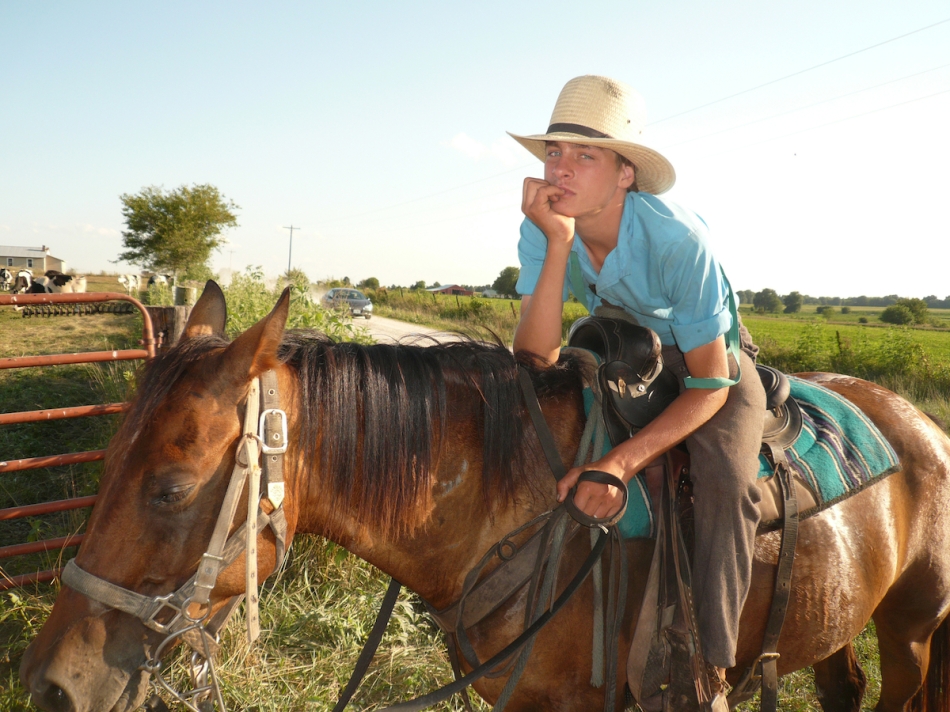 Still it is a hard life and the long hard Missouri winters do not make it any easier so when a colony runs out of farm land, often groups will break away, move someplace new, cousins from Ohio perhaps might join them and a new colony is born. These kids live at Ten Mile Corner northeast of Macon, Missouri but most of these families migrated from the Old Order Clark area and started fresh here, they now allow stocking caps instead of the open Beaver Hat, snow guards for the open buggy’s and men can now work in town daily, if need be.
Still it is a hard life and the long hard Missouri winters do not make it any easier so when a colony runs out of farm land, often groups will break away, move someplace new, cousins from Ohio perhaps might join them and a new colony is born. These kids live at Ten Mile Corner northeast of Macon, Missouri but most of these families migrated from the Old Order Clark area and started fresh here, they now allow stocking caps instead of the open Beaver Hat, snow guards for the open buggy’s and men can now work in town daily, if need be.
 Willie Petersheim shys away from the camera as his wife and baby freeze time with a photo to document their sons birth.
Willie Petersheim shys away from the camera as his wife and baby freeze time with a photo to document their sons birth. Most Amish have two or three jobs or strategies for income, some bake, make carpets or knit, others make furniture, cabinets as well as their crops and livestock.
Most Amish have two or three jobs or strategies for income, some bake, make carpets or knit, others make furniture, cabinets as well as their crops and livestock.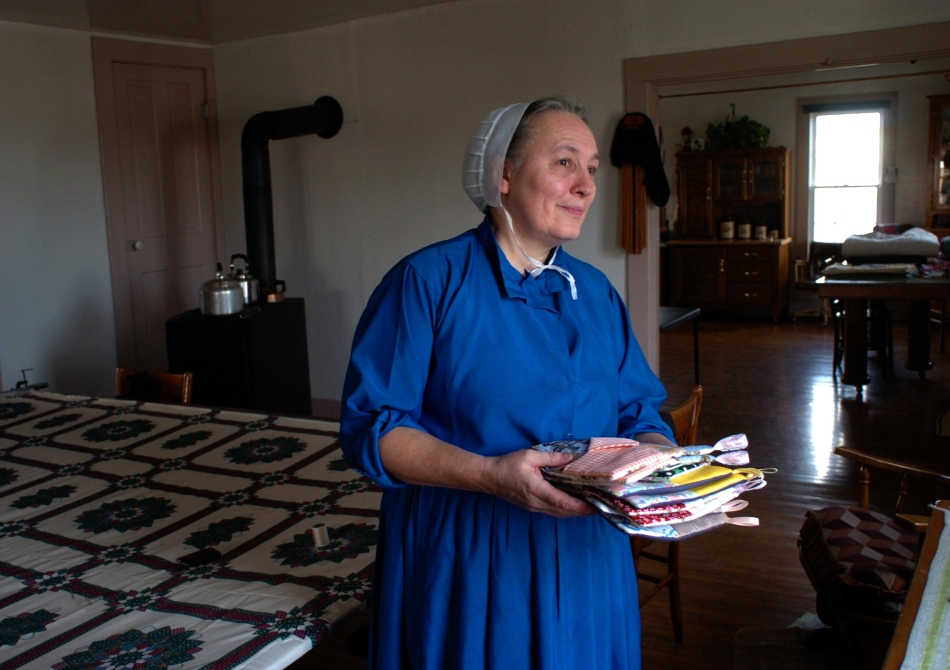 The entire community comes together in times of need, the Amish Barn Raising is not something you see every day but still it is that community spirit most folks associate with Amish and Mennonite Religious Communities.
The entire community comes together in times of need, the Amish Barn Raising is not something you see every day but still it is that community spirit most folks associate with Amish and Mennonite Religious Communities. From an early age, small Amish children take control of huge work horses, working them in the fields, pulling wagons and disciplining the huge workers.<img
From an early age, small Amish children take control of huge work horses, working them in the fields, pulling wagons and disciplining the huge workers.<img 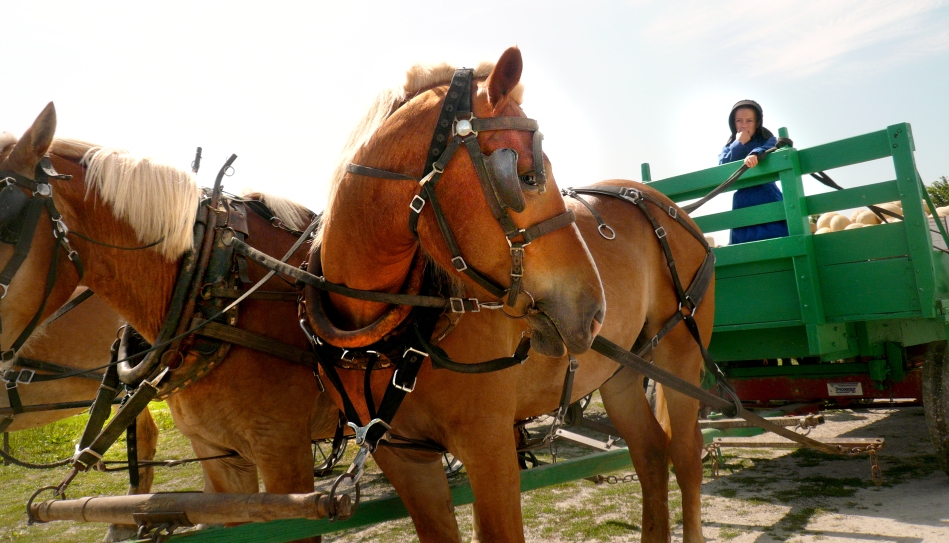 Remember your dad talk about when he was a boy how far he had to walk to school, Amish kids really do it and they do it in rain and snow. Each school has a wood stove, students are responsible to keep the heat up and young graduates of the School, often teach but at time retirees help out, it is usually whoever has the time. Each Church district is made up of ministers, deacons and the Bishop. The Bishop serves for life and he is chosen by the community through a vote. “We let GOD decide!” says Benny Borntreiger, three nominees names are placed in a hat and a visiting deacon will pull the name from the hat. Their election will last for a lifetime or until the move from the colony.Snow days can be a day off from some chores and a chance to run down to the pond and enjoy the skating and sledding before the ice is harvested, cut into chucks, and placed in a foam igloo which serves to cool their produce like berries into the hot summer months…
Remember your dad talk about when he was a boy how far he had to walk to school, Amish kids really do it and they do it in rain and snow. Each school has a wood stove, students are responsible to keep the heat up and young graduates of the School, often teach but at time retirees help out, it is usually whoever has the time. Each Church district is made up of ministers, deacons and the Bishop. The Bishop serves for life and he is chosen by the community through a vote. “We let GOD decide!” says Benny Borntreiger, three nominees names are placed in a hat and a visiting deacon will pull the name from the hat. Their election will last for a lifetime or until the move from the colony.Snow days can be a day off from some chores and a chance to run down to the pond and enjoy the skating and sledding before the ice is harvested, cut into chucks, and placed in a foam igloo which serves to cool their produce like berries into the hot summer months… <img src=”http://oldorderamish.files.wordpress.com/2011/02/snowy-walk-colorsharp.jpg” alt=”” />Sundays is a day of rest and visiting. Districts pass the Sunday meeting around to member homes and folks will show up for much of the day.
<img src=”http://oldorderamish.files.wordpress.com/2011/02/snowy-walk-colorsharp.jpg” alt=”” />Sundays is a day of rest and visiting. Districts pass the Sunday meeting around to member homes and folks will show up for much of the day.  Much of the daily responsibilities change according to what time of year it is because an Amish farmer’s life is driven by his crops and the weather, both tough masters.
Much of the daily responsibilities change according to what time of year it is because an Amish farmer’s life is driven by his crops and the weather, both tough masters.
 Family is everything in the AMISH community and the family teaches their children a Dutch/Germanic dialect until they are 5 or 6 then when they begin school they learn English.
Family is everything in the AMISH community and the family teaches their children a Dutch/Germanic dialect until they are 5 or 6 then when they begin school they learn English.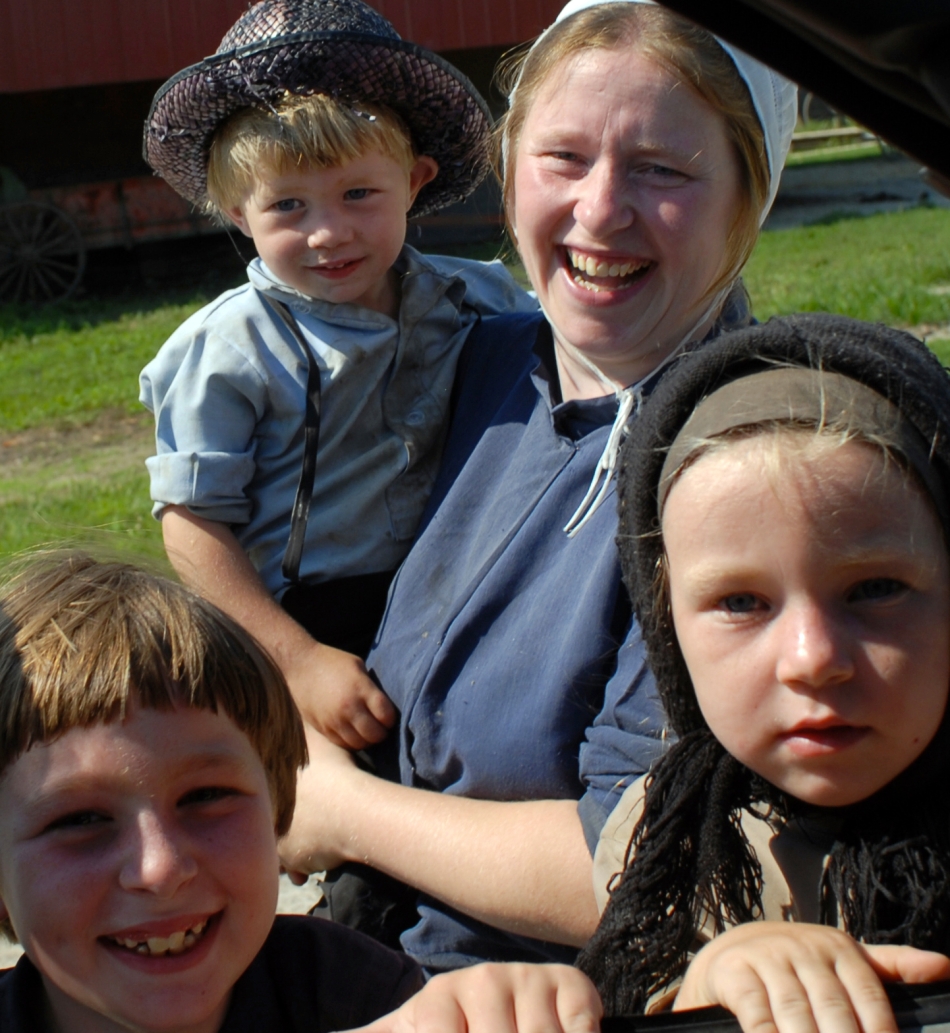
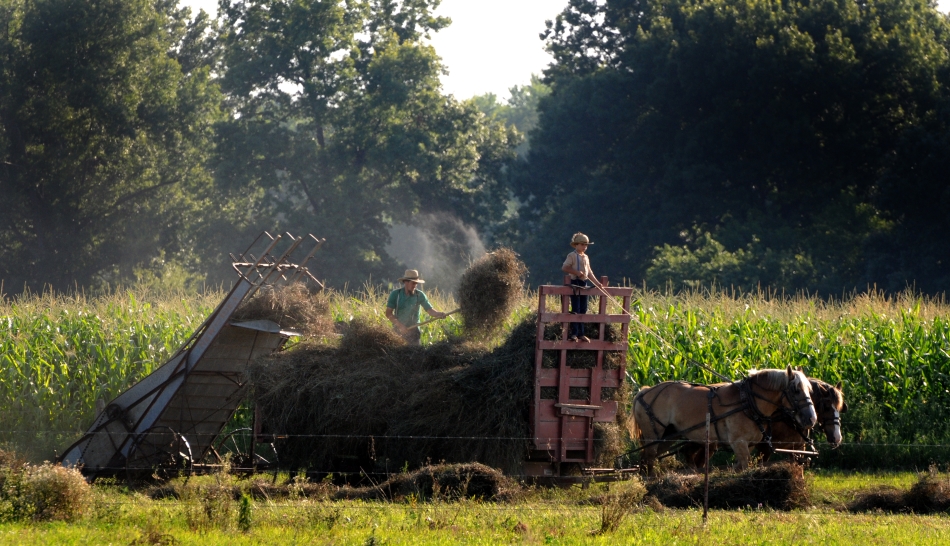 <img src=”https://oldorderamish.files.wordpress.com/2011/02/plowday7154best.jpg” alt=”MISSOURI WEATHER DISHES OUT FEW GOOD DAYS FOR WORKING” /><img ” alt=”BIRTHS ADD WORKERS TO THE BARNYARD” />
<img src=”https://oldorderamish.files.wordpress.com/2011/02/plowday7154best.jpg” alt=”MISSOURI WEATHER DISHES OUT FEW GOOD DAYS FOR WORKING” /><img ” alt=”BIRTHS ADD WORKERS TO THE BARNYARD” />

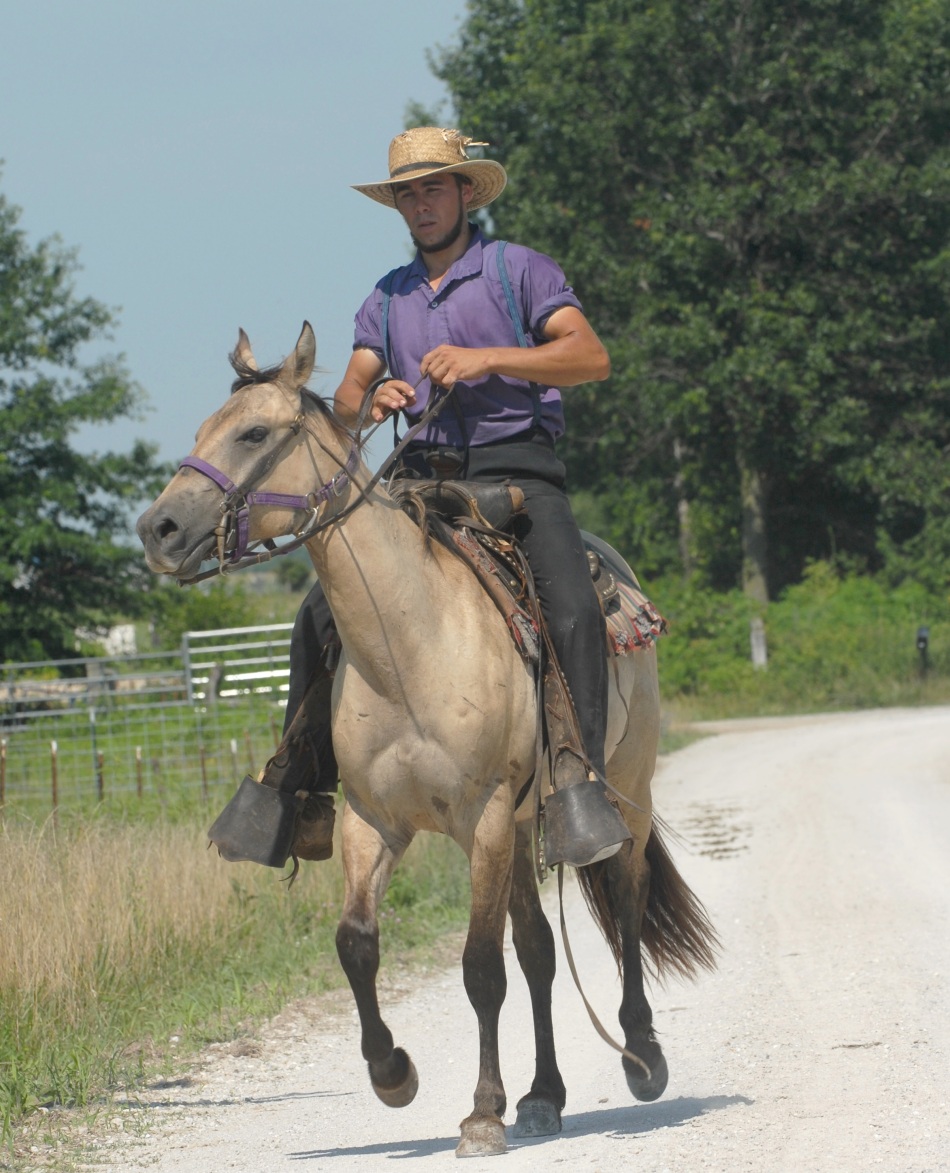

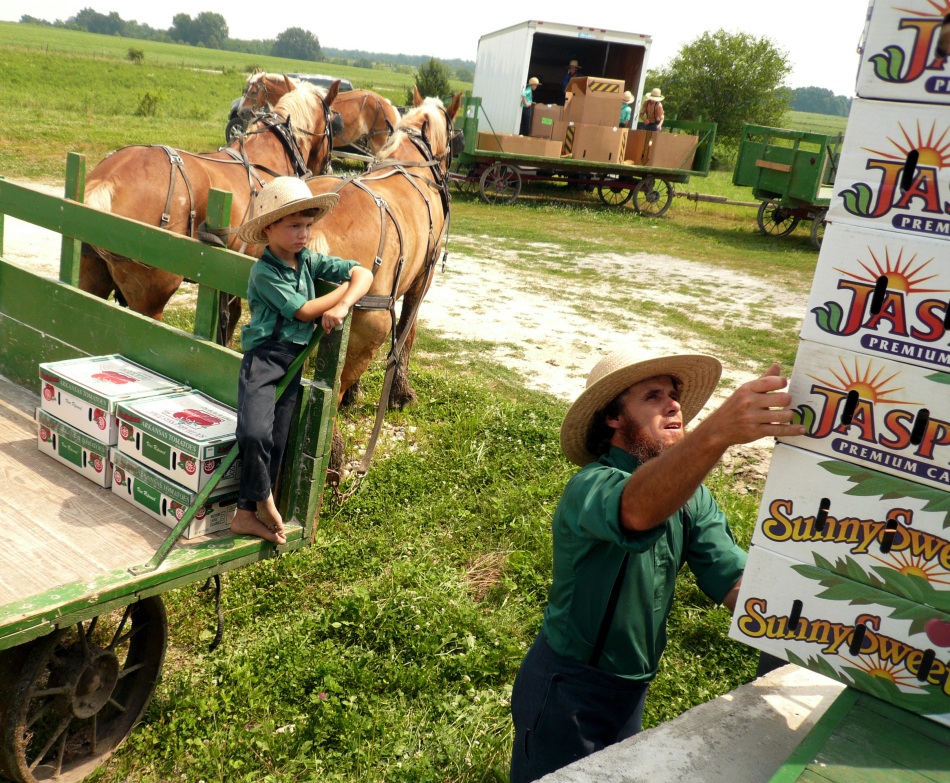

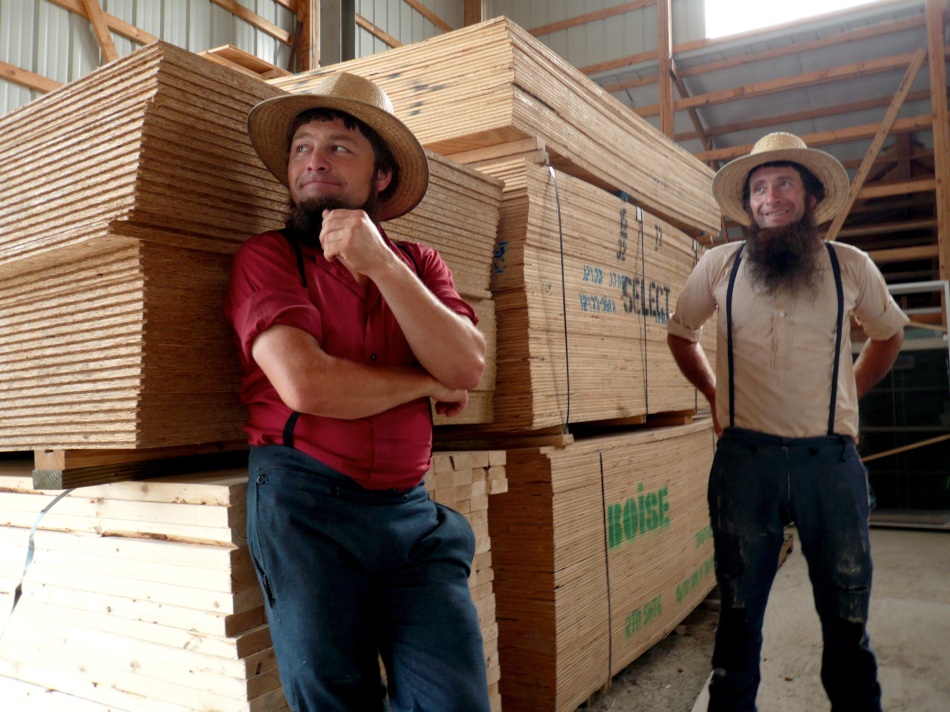 DURING THE GROWING SEASON THE COLONY RUNS A PRODUCE MARKET THAT SELLS to commercial outlets, local grocery chains
DURING THE GROWING SEASON THE COLONY RUNS A PRODUCE MARKET THAT SELLS to commercial outlets, local grocery chains 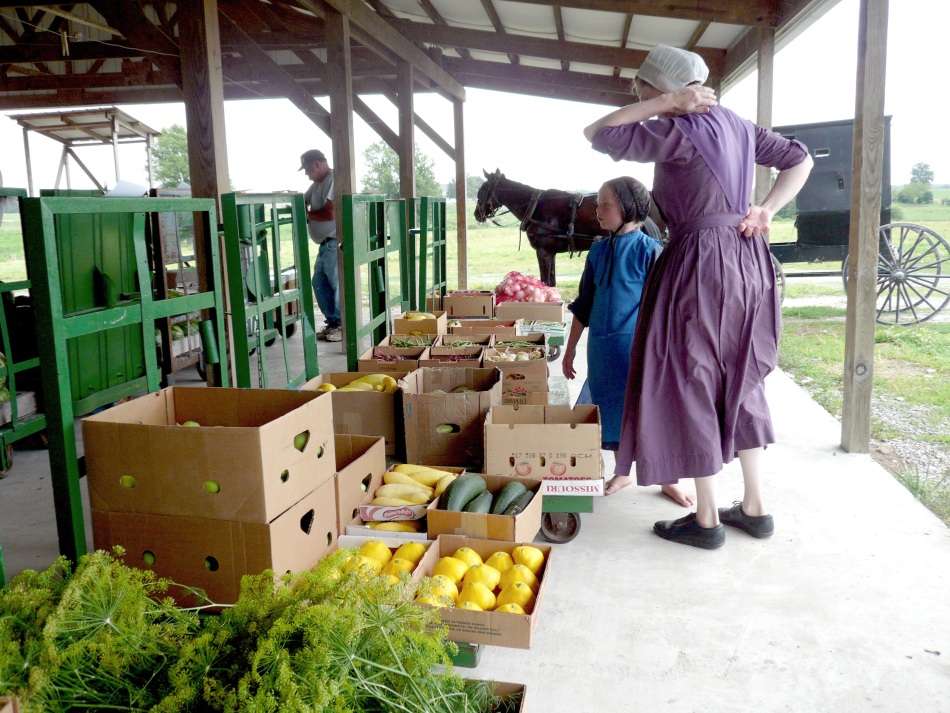

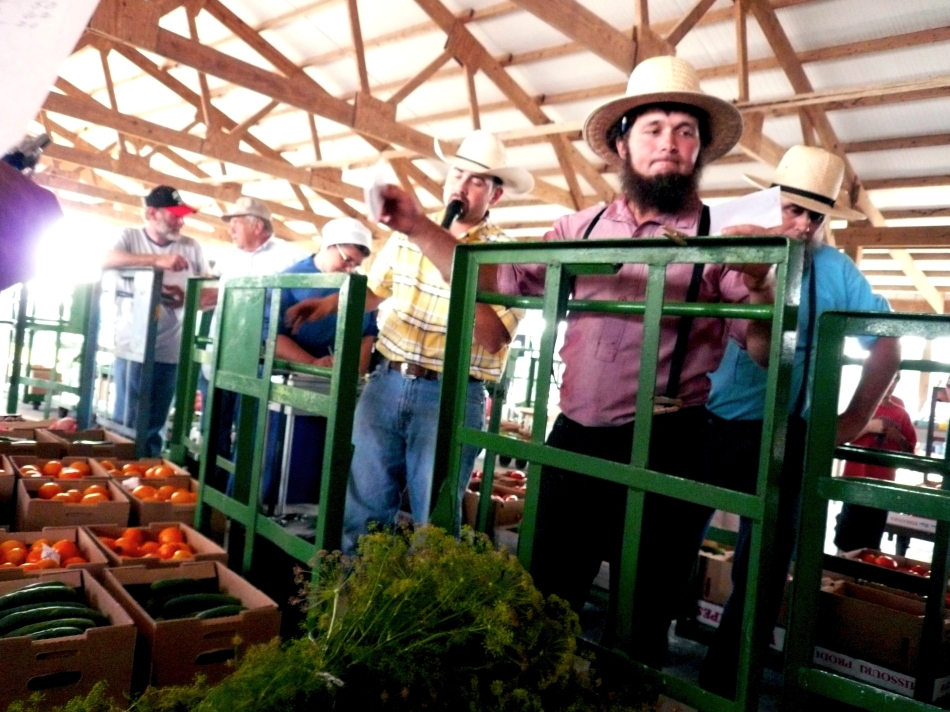

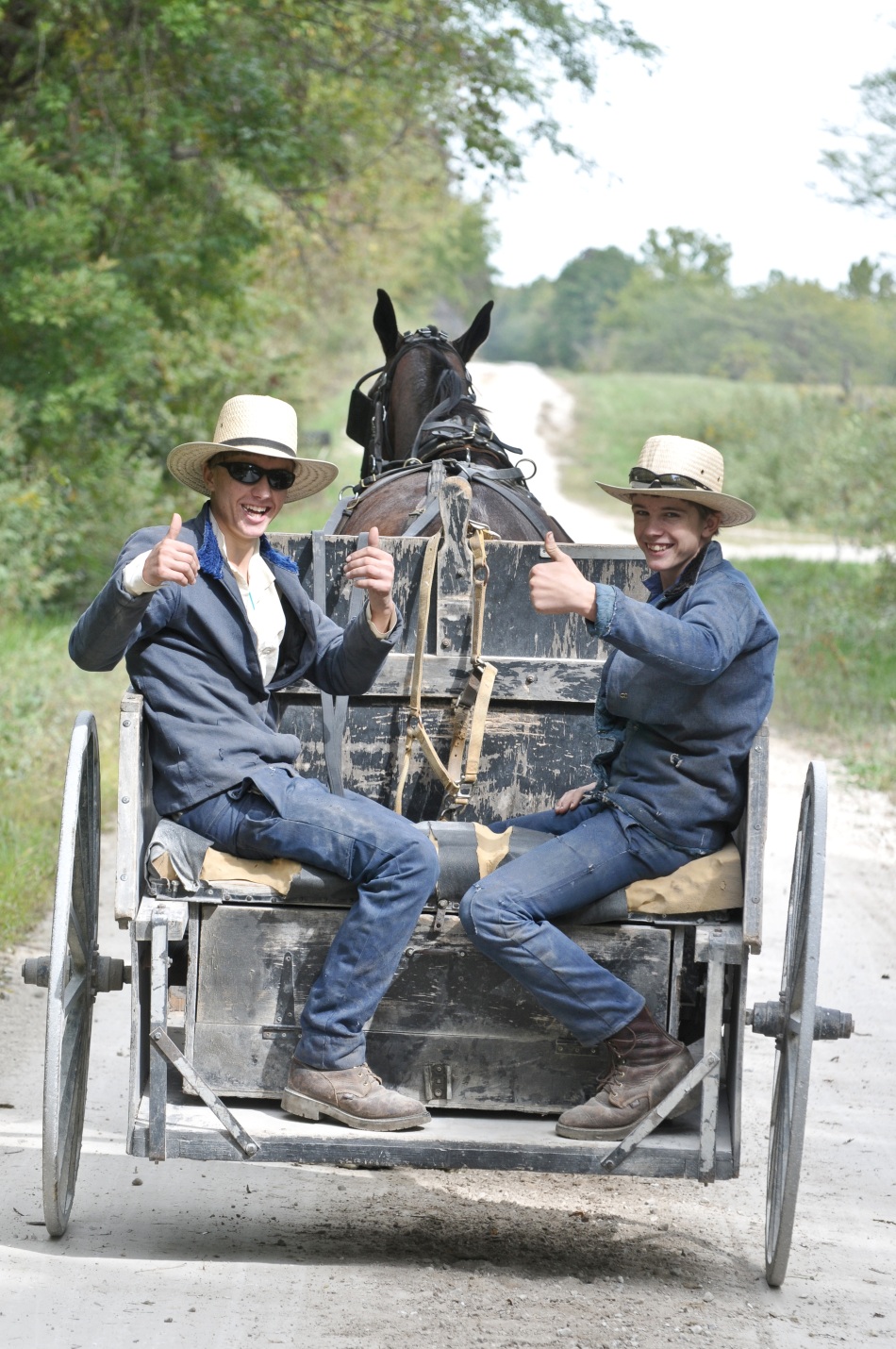

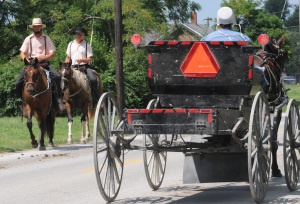

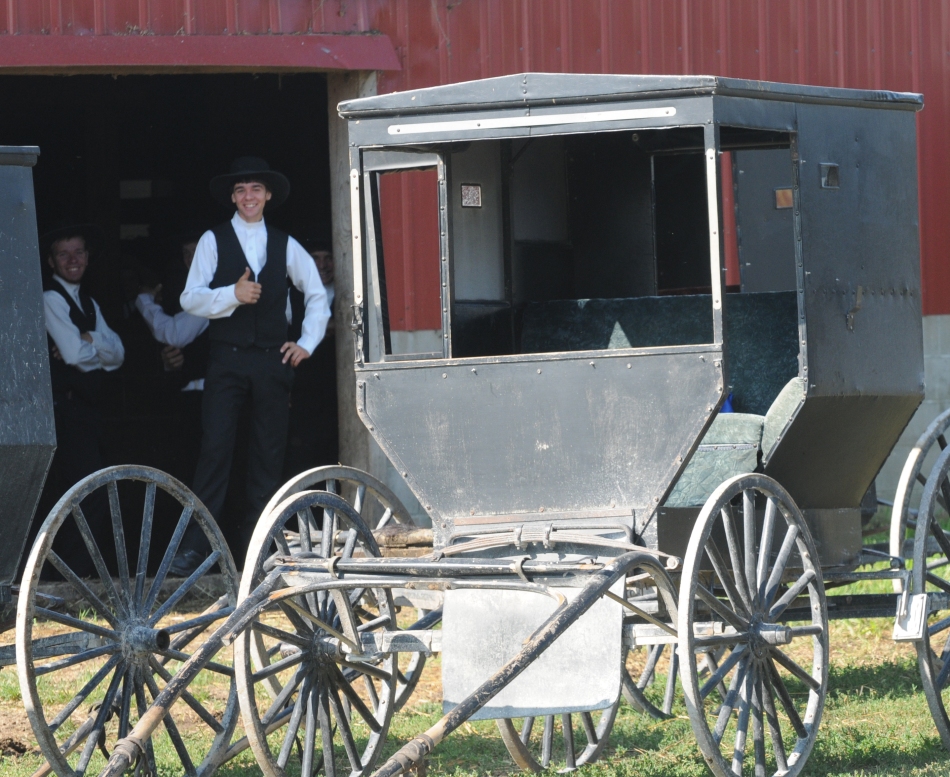

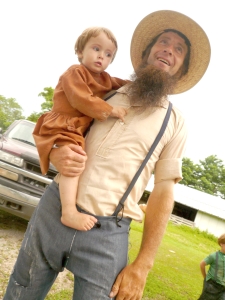
Hi, this is a comment.
To delete a comment, just log in, and view the posts’ comments, there you will have the option to edit or delete them.
February 16, 2011 at 5:44 am
Pingback: AMISH FALL ENDS MID-MISSOURI SEASONAL CYCLE HARD WORK BEGINS ANEW BEFORE THE SNOW FLYS « SOUTHWEST PHOTO JOURNAL
i lived near clark for a while i found the amish we delt with honest and friendly. with a fun relaxed sense of humor….i like going to the produce auction great deals fun and entertaining….and a piece of homemade pie for a buck…hope to move back to the area soon great website my friend…
December 27, 2011 at 4:46 pm
I live 40 minutes from Jamesport. How did you get these pictures when the Amish in Jamesport shy away from the camera, and even ask that no pictures be taken? I’m referring to the “posed” shots. Please respect their beliefs. The locals do.
June 2, 2012 at 5:37 am
My Clark Amish friends are not unlike everyone else their babies grow up fast and without a family photo that part of life is fleeting. Like yourself, they visit this web site when visiting neighbors and the little girl says “Daddy whose is that little girl with you”! “That’s you. See how much you’ve grown”!
I have known these folks for decades some have come to accept me and I’m not pushy, they kids call me “The Pictureman”, some ask me to take their pictures. They elders smile and say, “teen-agers, they are the same everywhere”. These are just pictures of my friends and their families. Thanks for visiting……
June 2, 2012 at 5:46 am
My husband and I are going to visit Clark today; hope we find some neat stuff – I’d love to send some Amish-made goods to my brother in Japan and maybe some sturdy furniture for our home. Great website!
June 30, 2012 at 3:00 pm
Hi PK…love your stories and pictures here. We visit Amish country frequently and enjoy each and every trip!
July 20, 2012 at 8:55 pm
The expression of our constitution allows us all the “right of liberty and the pursuit happiness”. Many of my Amish brothers and sisters feel like I do when I say we all have this right of freedom to live as we choose and worship as we may. They are a beacon of light in a society that continues to diminish these God-given rights. May we all stand true to our beliefs and traditions no matter what force apposes them.
August 4, 2012 at 5:19 pm
oh, so true! All created equal.
August 24, 2012 at 5:59 pm
Wonderful place to visit. The bakery goods…furniture such fine goods. Quilts are gorgeous
/
September 2, 2012 at 3:46 pm
I am wanting to know when there will be an amish auction south of Moberly toward Clark area.
August 9, 2013 at 2:11 am
I would get out there on Tuesday around 10 am and plan to stay for lunch….be sure to drive
the countryside and check out the bakeries, Thursday is a big baking day……..
August 12, 2013 at 3:42 am
You post very interesting content here. Your website
deserves much more traffic. It can go viral if you give it initial boost, i know
very useful service that can help you, simply search in google:
svetsern traffic tips
January 2, 2015 at 8:38 am
Lovely read . Very uplifting
April 5, 2016 at 8:23 am